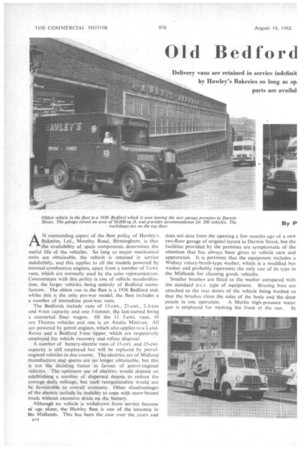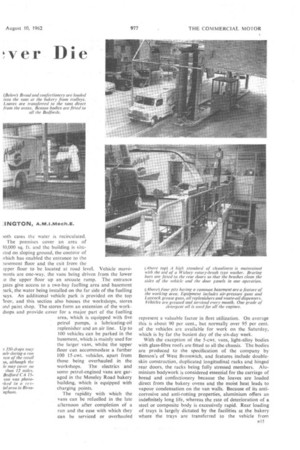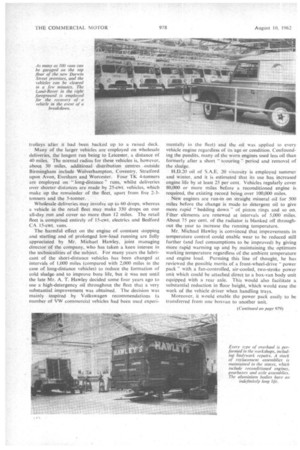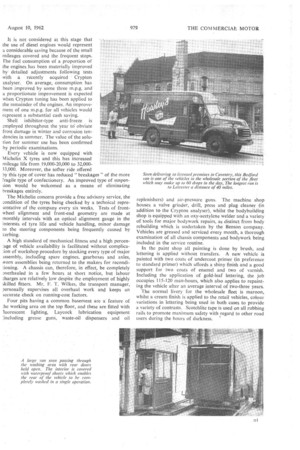Old Bedford ver Die
Page 48

Page 49

Page 50

Page 55

If you've noticed an error in this article please click here to report it so we can fix it.
Delivery vans are retained in service indefinit by Hawley's Bakeries so long as sp.
parts are availat By P
INGTON, AN outstanding aspect of the fleet policy of Hawley's Bakeries, Ltd., Moseley Road, Birmingham, is that . the availability of spare components determines the useful life of the vehicles. So long as major mechanical units are obtainable, the vehicle is retained in service indefinitely, and this applies to all the models powered by internal-combustion engines, apart from a number of 5-cwt. vans, which are normally used by the sales representatives. Concomitant with this policy is one Of vehicle standardization, the larger vehicles being entirely of Bedford manufacture, The oldest van in the fleet is a 1936 Bedford and, whilst this is the only pre-war model, the fleet includes a a number of immediate post-war vans.
The Bedfords include vans of 15-cwt., 25-cwt., 2-3-ton and 4-ton capacity and one 5-tonner, the last-named being a converted flour wagon. Of the 11 5-cwt. vans, 10 are Thames vehicles and one is an Austin Minivan. All are powered by petrol engines, which also applies to a LandRover and a Bedford 5-ton tipper, which are respectively employed for vehicle recovery and refuse disposal.
A number of battery-electric vans of 15-cwt. and 25-cwt. capacity is still employed but will be replaced by petrolengined vehicles in due course. The electrics are of Midland manufacture and spares are no longer obtainable, but this is not the deciding factor in favour of petrol-erigined vehicles. The optimum use of electrics would depend on establishing a number of dispersed depots to reduce the average daily mileage, but such reorganization would not be favourable to overall economy. Other disadvantages of the electric include its inability to cope with snow-bound roads without excessive drain on the battery.
Although no vehicle is withdrawn from service because of age alone, the Hawley fleet is one of the 'smartest in the. Midlands. This has been the case over the years and does not date from the opening a few months ago of a new two-floor garage of original layout in Darwin Street, but the facilities provided by the premises are symptomatic of the attention that has always been given to vehicle care and appearance. It is pertinent that the equipment includes a Widney rotary-brush-type washer, which is a modified bus washer and probably represents the only one of its type in the Midlands for cleaning goods vehicles.
Smaller brushes are fitted to the washer compared with the standard p.s.v. type of equipment. Bracing bars are attached to the rear doors of the vehicle being washed so that the brushes clean the sides of the body and the door panels in one operation. A Merlin high-pressure water
gun is employed for washing the front of the van. In
toth cases the water is recirculated.
The premises cover an area of 10,000 sq. ft. and the building is snuffed on sloping ground, the contour of uhich has enabled the entrance to the asement floor and the exit from the ipper floor to be located at road level. Vehicle movehents are one-way, the vans being driven from the lower o the upper floor up all arcuate ramp. The entrance gates give access to a two-bay fuelling area and basement 3ark, the water being installed on the far side of the fuelling mys. An additional vehicle park is provided on the top loor, -and this section also houses the workshops, stores ind paint shop. The stores form an extension of the workshops and provide cover for a major part of the fuelling area, which is equipped with five petrol pumps, a lubricating-oil replenisher and an air line.. Up to 100 vehicles can be parked in the basement, which is mainly used for the larger vans, whilst the upper floor can accommodate a further 100 15-cwt. vehicles, apart from those being overhauled in the workshops. The electrics and some petrol-engined vans are garaged in the Moseley Road bakery building, which is equipped with charging points.
350 drops may ade during a run Van of the retail m, although the le may cover no than 12 miles. Bedford CA 75van was photo ■ hed in a resial area in Birtn!Thant.
The rapidity with which the vans can be refuelled in the late afternoon after completion Of a run and the ease with which they can be serviced or overhauled represent a valuable factor in fleet utilization. On average this is about 90 per cent., but normally over 95 per cent. of the vehicles are available for work on the Saturday, which is by far the busiest day of the six-day week.
With the exception of the 5-cwt. vans, light-alloy bodies with glass-fibre roofs are fitted to all the chassis. The bodies are produced to the specification of the company by Benson's of West Bromwich, and features include doubleskin construction, duplicated longitudinal racks and hinged rear doors, the racks being fully stressed members. Aluminium bodywork is considered essential for the carriage of bread and confectionery because the loaves are loaded direct from the bakery ovens and the moist heat leads to vapour condensation on the van walls. Because of its anticorrosive and anti-rotting properties, aluminium offers an indefinitely long life, whereas the rate of deterioration of a steel or composite body is excessively rapid. Rear loading of trays is largely dictated by the facilities at the bakery where the trays are transferred to the vehicle from trolleys after it had been backed up to a raised deck.
Many of the larger vehicles are employed on wholesale deliveries, the longest run being to Leicester, a distance of 40 miles. The normal radius for these vehicles is, however, about 30 miles, additional distribution centres outside Birmingham include Wolverhampton, Coventry, Stratford upon Avon, Evesham and Worcester. Four TK 4-tonners are employed on "long-distance runs, whilst deliveries over shorter distances are made by 25-cwt. vehicles, which make up the remainder of the fleet, apart from five 2-3tonners and the 5-tonner.
Wholesale deliveries may involve up to 60 drops, whereas a vehicle in the retail fleet may make 350 drops on one all-day run and cover no more than 12 miles. The retail fleet is comprised entirely of 15-cwt. electrics and Bedford CA 15-cwt. vans.
The harmful effect on the engine of constant stopping and starting and of prolonged low-load running are fully appreciated by Mr. Michael Hawley, joint managing director of the company, who has taken a keen interest in the technicalities of the subject. For many years the lubricant of the short-distance vehicles has been changed at intervals of 1,000 miles (compared with 2,000 miles in the case of long-distance vehicles) to reduce the formation of cold sludge and to improve bore life, but it was not until the late Mr. A. T. Hawley decided some four years ago to use a high-detergency oil throughout the fleet that a very substantial improvement was obtained. The decision was mainly inspired by Volkswagen recommendations (a number of VW commercial vehicles had been used experi
mentally in the fleet) and the oil was applied to every vehicle engine regardless of its age or condition. Confounding the pundits, many of the worn engines used less oil than formerly after a short "Scouring period and removal of the sludge.
H.D.20 oil of S.A.E. 20 viscosity is employed summer and winter, and it is estimated that its use has increased engine life by at least 25 per cent. Vehicles regularly cover 80,000 or more miles before a reconditioned engine is requited, the existing record being over 100,000 miles.
New engines are run-in on straight mineral oil for 500 miles before the change is made to detergent oil to give more rapid " bedding down" of piston rings and so on. Filter elements are renewed at intervals of 5,000 miles. About 75 per cent, of the radiator is blanked off throughout the year to increase the running temperature.
Mr. Michael Hawley is convinced that improvements in temperature control could enable wear to be reduced still further (and fuel consumptions to be improved) by giving more rapid warming up and by maintaining the optimum working temperature regardless of the ambient temperature and engine load. Pursuing this line of thought, he has reviewed the possible merits of a front-wheel-drive "power pack with a fan-controlled, air-cooled, two-stroke power unit which could be attached direct to a box-van body unit equipped with a rear axle. This would also facilitate a substantial reduction in floor height, which would ease the work of the vehicle driver when handling trays.
Moreover, it would enable the power pack easily to be transferred from one boxvan to another unit. It is not considered at this stage that the use of diesel engines would represent a considerable saving because of the small mileages covered and the frequent stops. The fuel consumption of a proportion of the engines has been materially improved by detailed adjustments following tests with a recently acquired Crypton analyser. On average, consumption has been improved by some three m.p.g and a proportionate improvement is expected when Crypton tuning has been applied to the remainder of the engines. An improvement of one mpg. for all vehicles would represent a substantial cash saving.
Shell inhibitor-type anti-freeze is employed throughout the year to' obviate frost damage in winter and corrosion tendencies in summer. The value of the solution for summer use has been confirmed by periodic examinations.
Every vehicle is now equipped with Michelin X tyres and this has increased mileage life from s19,000-20,000 to 32,00013,000. Moreover, the softer ride offered Py this type of cover has reduced " •breakages " of the more Fragile type of confectionery. An improved type of suspen;ion would be welcomed as a means of eliminating breakages entirely.
The Michelin concern provide a free advisory service, the condition of the-tyres being checked by a technical representative of the company every six weeks. Tests of front wheel alignment and front-end geometry are made at monthly intervals with an optical alignment gauge in the interests of tyre life and vehicle handling, minor damage to the steering components being frequently caused by kerbing.
A high standard of mechanical fitness and a high percen:age a vehicle availability is facilitated without cornplica:ion of workshop procedure by stocking every type of major assembly, including spare engines, gearboxes apd axles, worn assemblies being returned to the makers for recondijoning. A chassis can, therefore, in effect, be completely )verhauled in a few hours at short notice, but labour :harges are relatively low despite the employment of highly ikilled fitters. Mr. F. T. Wilkes, the transport manager, personally supervises all overhaul work and keeps an tccurate check on running-cost factors.
Four pits having a common basement are a feature of he working area on the top floor, and these are fitted with luorescent lighting, Laycock lubrication equipment "including grease guns, waste-oil dispensers and oil replenishers) and air-pressure guns. The machine shop houses a valve grinder, drill, press and plug cleaner (in addition to the Crypton analyser), whilst the bodybuilding shop is equipped with an oxy-acetylene welder and a variety of tools for major bodywork repairs, as distinct from body rebuilding which is undertaken by the Benson company. Vehicles are greased and serviced every month, a thorough examination of all chassis components and bodywork being included in the service routine.
In the paint shop all painting is done by brush, and lettering is applied without transfers. A new vehicle is painted with two coats of undercoat primer (in preference to standard primer) which affords a shiny finish and a good support for two coats of enamel and two of varnish. Including the application of gold-leaf lettering, the job occupies 115-120 man-hours, which also applies to repainting the vehicle after an average interval of two-three years.
The normal livery for the wholesale fleet is maroon, whilst a cream finish is applied to the retail vehicles, colour variations in lettering being used in both cases to provide a variety of contrasts.. Scotchlite tape is used on all rubbing rails to promote maximum safety with regard to other road users during the hours of darkness.
















































































































